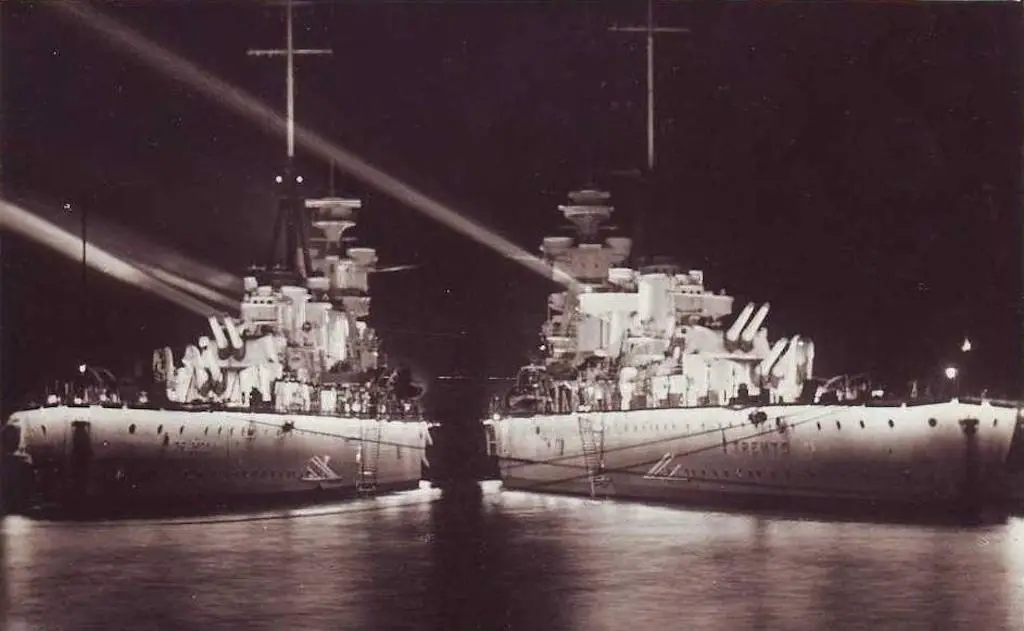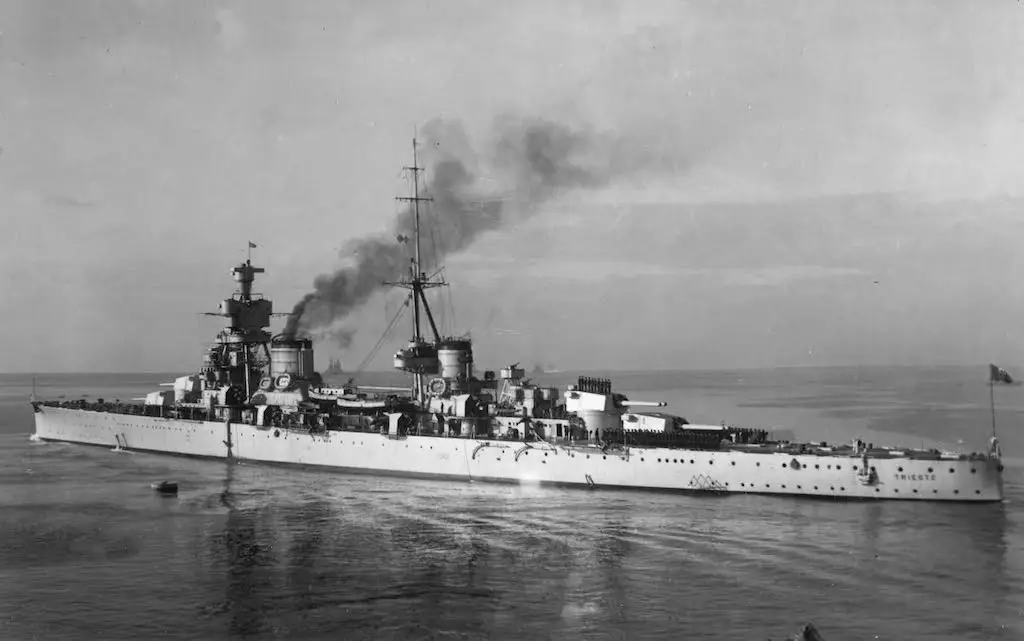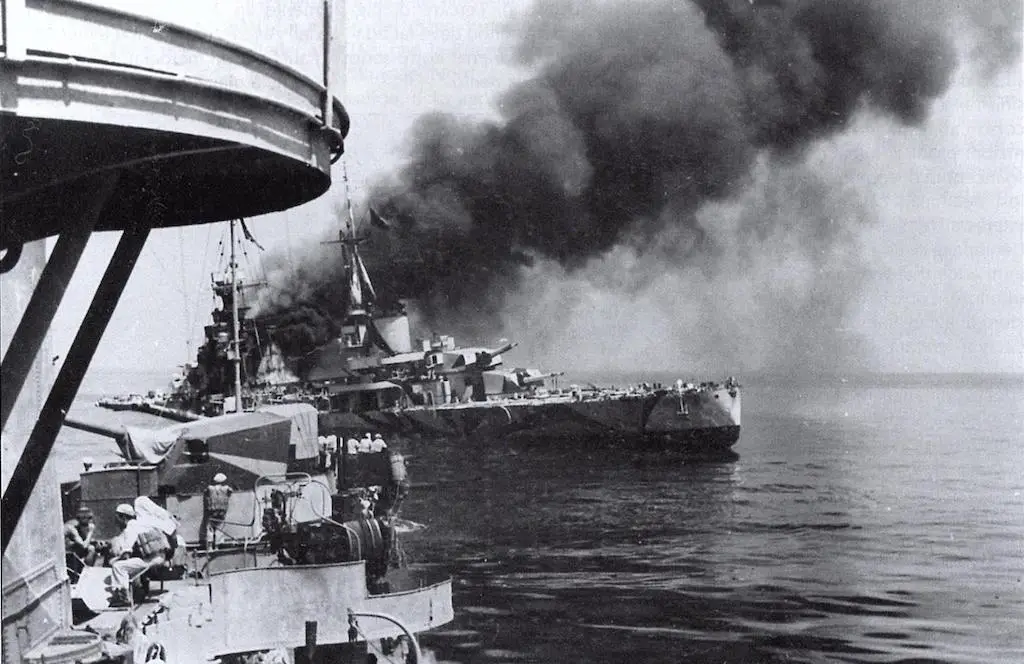When one searches for the precursor to the impressive and elegant Zara-class cruisers, they find the Trento class. This class includes the Trento, Trieste, and what many consider their sister ship, Bolzano. Trento’s construction began on 8 February 1925 and completed on 3 April 1929. Her first sister, Trieste followed, construction beginning on 22 June 1925 and completed on 21 December 1928. Construction on the Bolzano began on 11 June 1930 and the five years made a tremendous difference in her design.
| Ship | Builder | Laid Down | Launched | Completed |
|---|---|---|---|---|
| Trento | Odero Terni Orlando | 8 February 1925 | 4 October 1927 | 3 April 1929 |
| Trieste | Stabilimento Tecnico Triestino | 22 June 1925 | 20 October 1926 | 21 December 1928 |
| Bolzano | Gio. Ansaldo & C. Genoa | 11 June 1930 | 31 August 1932 | 19 August 1933 |
Interwar Design Limitations
Full of curiosities, the deeply imbalanced class offers a glimpse into the circumstances of interwar Italy. The limitations of the Washington Naval Treaty perhaps weigh the most heavily on it. However, the arms race with France and evolving Italian naval philosophy each show their mark on the ships. You can make a stark example of the developmental crossroads Italy stood at in the ’20s. That is, the Bolzano was thoroughly modified as to arguably be a class unto herself.

A 1939 photo of the Trento and Trieste docked at Leghorn.
Speed Over Armor
As the French laid down their new Duquesne-Class heavy cruisers, the Regia Marina was quick to seek a counter. Their result was the Trento Class, a fast, well-armed class which could theoretically engage their rivals on even terms. Early Italian doctrine allowed that speed might compensate for poor armor, and that speed was additionally paramount. As Italy possessed a long, vulnerable coastline and overseas commitments, high command placed a premium upon speed.

The Trento class cruiser Trieste moored in Naples, Italy.
Exceeding 31 knots an hour, they indeed boasted great speed for a ship of the ’20s. However, to achieve this while staying within the limits of the Washington Naval Treaty, the designers made many concessions. To cut down the weight, the design maintained a thin armor belt. Additionally, the designers narrowed the hull, reducing stability in rough waters. While not a serious flaw in the peaceful confines of the Mediterranean, it does bear mentioning.
Corrections Made for the Zara Class
Naval officers expressed fear that the light armor of the Trento class could become a severe liability. As such, the heavy cruiser Bolzano enjoyed many improvements, based upon the Trento hull but being influenced by the Zaras. The Zaras themselves boasted an impressively thick armor belt, in direct reaction to the criticism lain upon their predecessors.
Design of Trento Class Cruisers
The Trento Class cruisers required a 783 man crew to operate effectively in wartime. At an empty load, they displaced 10,344 long tons, but on a full load, this increased to 13,334 tons. They possessed dimensions of 196.96 m in length, a 20.6 m beam, and a 6.8 m draft. Twelve yarrow boilers provided 150,000 shp and the impressive 31 knot top speed. At cruising speeds, the operational range of the class reached 4,160 nautical miles. Each vessel carried two IMAM Ro.43 seaplanes for reconnaissance duties.

The Trieste leaving the port of Taranto.
Armament
Four double turrets of 203mm guns formed the center of their offensive, anti-ship firepower. Four double torpedo tubes of 533mm torpedoes augmented this and could devastate enemy battleships. To fend off destroyers and light ships, they mounted eight double turrets of 100mm guns. Their antiair armament was subject to change, starting at four 40mm AA guns and a complement of machine guns. They did away with this inadequate setup, replacing it with four dual-mount 37mm guns. Additionally, they carried 4-8 20mm AA guns.
The weakest point of the ship was the armor. Contemporary cruiser weapons would find no resistance from their 70mm belt armor. In places, the deck armor was as thin as 20mm. At the thickest, the deck only offered 50mm of armor. The turret faces and conning tower possessed the thickest armor, at 100mm. The turret barbettes, however, comprised only 70mm of protection.
Un Errore Splendidamente Riuscito – The Bolzano Cruiser

The fore turrets of the Bolzano.
Despite arriving after the construction of the Zara class, Bolzano’s structure was nearly identical to the Trento Class cruisers. The gun layout was identical, but it adopted the improved, high-caliber 203mm gun of the Zaras. Several other innovations, such as more powerful boilers improved Bolzano’s design. She shared the light construction of her sisters and the improved technology of the Zaras. With these traits together, Bolzano cut through the waves at a top speed of 36 knots. Certainly an impressive ship, it still clung to outdated notions about the balance between speed and armor. As such, many knew it as ‘an error splendidly executed.’
Wartime Service
The three ships of the Trento Class figured heavily into the early, pitched naval battles in the Mediterranean. Initially, they served together in the Second Division of the Second Squadron. In the Battle of Punta Stilo (Calabria), all three fought boldly alongside the battleships Conte di Cavour and Giulio Cesare. One or more featured in most of the major battles of the Mediterranean Theater. This includes battles such as Cape Teulada (Spartivento) or Gaudo (Cape Matapan) and many convoy battles.

Bolzano in flames after being hit by a torpedo from the HMS Unbroken on 13 August 1942, Image was taken on the Geniere.
Fate of Bolzano
Despite the concern over their light armor, they survived several engagements and submarine attacks throughout the war. Bolzano suffered a torpedo attack by HMS Triumph in late August 1941 but was operational by November. She was not so lucky on 13 August 1942, as she was attacked by HMS Unbroken. Torpedoes fired from the British submarine crippled the cruiser, bringing an early end to her career. She was the subject of reconstructive ideas within the Regia Marina. However, a dearth of all resources left these ideas theoretical. Ultimately, the last action involving her was her destruction by a task force of Anglo-Italian frogmen on 21-22 June 1944. Her refloating in 1949 was promptly followed with her being sold for scrap.
Fate of Trieste and Trento
While intercepting the Operation Harpoon Convoy during June 1942, Trento suffered successive torpedo hits and sunk. Casualties approached 50%, with 570 men dying out of 1,157. Damage suffered in November 1941 at the hands of the submarine HMS Utmost took Trieste out of action for nearly a year. While she returned to action in August 1942, she undertook no operations before being sunk by US heavy bombers in 1943. She rested there for seven years until her refloating in 1950. Afterward, Spain purchased what was left of her. The Spanish Navy held an interest in converting her to serve as a light aircraft carrier. This came to nothing, however, as the project made little progress. Ultimately, the Spanish navy scrapped her in 1956.
Specifications
| Class | Trento |
|---|---|
| Type | Heavy Cruiser |
| Built | 1925-1930 |
| Displacement | 13,334 tons |
| Length | 646 ft 2 in (196.9 m) |
| Beam | 67 ft 7 in (20.6 m) |
| Propulsion | 150,000 shp (110,000 kW) 4 Parson Turbines |
| Speed | 35.6 knots |
| Range | 4,160 nm |
| Crew | 781 |
| Armament | (4) Twin 203 mm (8") guns (8) Twin 100 mm (4") / 47 caliber guns (4) 37 mm (1") AA Guns (4) or (8) 20 mm Breda 2 IMAM Ro.43 seaplanes |
| Armor | Deck: 20-50 mm (.79 to 1.97 in) Belt: 70 mm (2.8 in) Turret faces: 100 mm (3.9 in) Conning Tower: 100 mm (3.9 in) |
